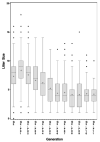The Collaborative Cross at Oak Ridge National Laboratory: developing a powerful resource for systems genetics
- PMID: 18716833
- PMCID: PMC2745091
- DOI: 10.1007/s00335-008-9135-8
The Collaborative Cross at Oak Ridge National Laboratory: developing a powerful resource for systems genetics
Abstract
Complex traits and disease comorbidity in humans and in model organisms are the result of naturally occurring polymorphisms that interact with each other and with the environment. To ensure the availability of resources needed to investigate biomolecular networks and systems-level phenotypes underlying complex traits, we have initiated breeding of a new genetic reference population of mice, the Collaborative Cross. This population has been designed to optimally support systems genetics analysis. Its novel and important features include a high level of genetic diversity, a large population size to ensure sufficient power in high-dimensional studies, and high mapping precision through accumulation of independent recombination events. Implementation of the Collaborative Cross has been ongoing at the Oak Ridge National Laboratory (ORNL) since May 2005. Production has been systematically managed using a software-assisted breeding program with fully traceable lineages, performed in a controlled environment. Currently, there are 650 lines in production, and close to 200 lines are now beyond their seventh generation of inbreeding. Retired breeders enter a high-throughput phenotyping protocol and DNA samples are banked for analyses of recombination history, allele drift and loss, and population structure. Herein we present a progress report of the Collaborative Cross breeding program at ORNL and a description of the kinds of investigations that this resource will support.
Figures







References
-
- Churchill GA, Airey DC, Allayee H, Angel JM, Attie AD, et al. The Collaborative Cross, a community resource for the genetic analysis of complex traits. Nat Genet. 2004;36(11):1133–1137. - PubMed
Publication types
MeSH terms
Grants and funding
LinkOut - more resources
Full Text Sources
Molecular Biology Databases

